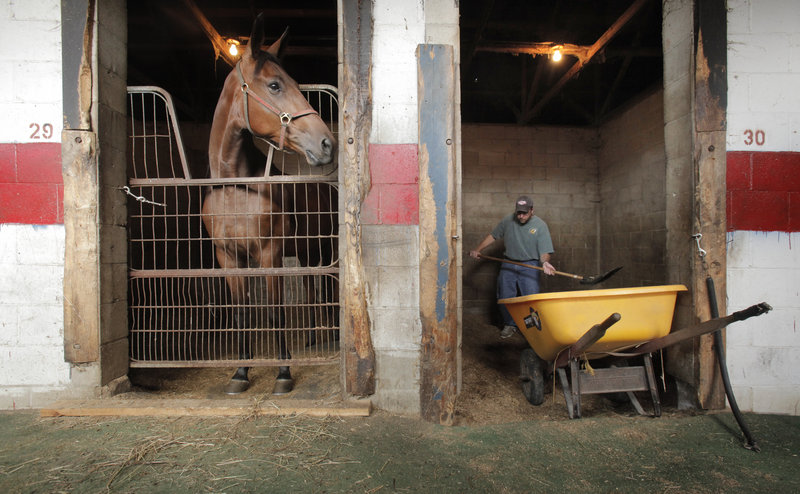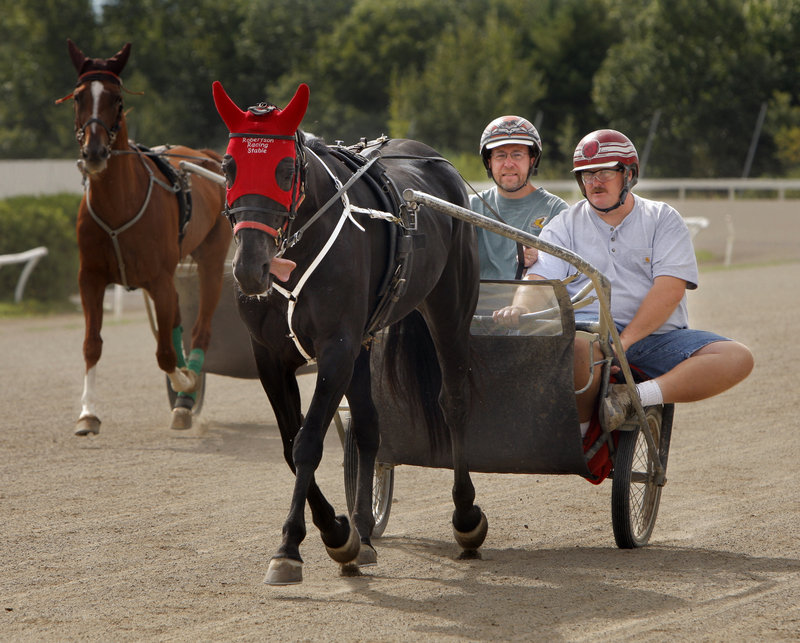SCARBOROUGH – I was actually looking forward to cleaning out the stalls.
When racehorse trainer Dick Robertson Jr. agreed to let me help out at his Robertson Racing Stables, I immediately thought the best way to learn about the job was to roll up my sleeves and shovel some horse manure. It seemed like a most basic, and most crucial, part of horse care.
What I didn’t know was how meticulous I had to be. In a strange economic twist, sawdust and wood chips have become very expensive for stables to buy in the last few years, largely because they are now made into pellet-stove fuel. So when Robertson told me to clean the stall, he also told me to do it without wasting any wood shavings.
Instead of just shoveling the poop into a wheelbarrow, I had to scoop it up on a plastic pitchfork and then gingerly shake and sift until I’d returned as much sawdust to the floor as possible.
Basically, cleaning the stall was like scooping out a giant cat-litter box.
“We used to get this stuff for next to nothing, but now it’s a major expense, so you’ve got to conserve every bit you can,” said Robertson, 42, as we surveyed the stall of a 12-year-old male named Mannart Sound Wave — “Manny” for short.
GETTING A GRIP ON THE JOB
Robertson has been training racehorses most of his life. He learned the business from his father, Dick Robertson Sr., who still trains horses at Scarborough Downs.
Even though caring for horses can seem idyllic, it’s a competitive business. The horses’ owners make money by winning races, so Robertson has a financial incentive to train winners — he gets paid by the horses’ owners.
Robertson runs the business with his wife, Renee. They care for about 15 horses at a time. Because they train horses who race at Scarborough Downs, they get to use stable facilities and Scarborough Downs’ two tracks for free.
Robertson spends a lot of time out on the track. A big part of his job is exercising the horses in his care and evaluating their physical condition. The morning I was at his stable, he was scheduled to take an 8-year-old female named Live in Lover for a little jog.
I would be in charge of this task, Robertson told me. I would sit in the jog cart (sort of like the sulkies used in harness racing at Scarborough Downs, but bigger and heavier) behind the horse and direct her with the reins.
Now, my only experience with horses came when I was 7, on a family horseback riding excursion. As soon as that horse started to move, I jumped off and watched him trot into the woods.
As I was putting on my helmet to ride in the jog cart at Scarborough Downs last week, the veterinarian who had been treating another of Robertson’s horses offered me this tidbit:
“I work with horses all day long, but I would be scared to death to ride in a jog cart,” said Dr. Martha Hart.
Robertson told me to get on the jog cart slowly and gingerly, so as to not spook the horse, whom he described as “a sweet girl” but excitable. Then he showed me how to grip the reins — which had an inside loop and an outside loop — with two fingers of one hand on one loop and the other three fingers on another. When I asked why, Robertson said, “That’s the way it’s done.”
As soon as we got into the cart, the horse wanted to go. I tugged on the left strap to get her to go more to the left, and on the right to go more to the right. Pretty simple — except she kept drifting over to the right because she had a habit of “playing with her tongue,” as Robertson put it. So her tongue would be hanging out on her left side, which somehow made her drift right.
Weird.
OUTSMARTED BY A HUNGRY HORSE
When we got to the practice track, the jogging track, Live in Lover picked up a little speed, so I had to pull back and slow her down a little. Then we went for a few laps on the actual racing track, with a much harder and faster surface, and she picked up her pace even more.
Mostly, she did the steering. Every once in a while, I’d have to pull her more to the left, to let a faster horse and driver go by. Robertson had talked a lot to me about safety when driving the jog cart, how every piece of equipment had to be installed properly to avoid problems.
And how important it is to understand, at all times, that you could never completely count on controlling a 1,000-pound racehorse.
“You have control, but you don’t have control,” said Robertson. “You’ve got to be aware of anything that could spook the horse — a flock of birds, a car, anything.”
After about 15 or 20 minutes of jogging, Live in Lover had heavy white streaks of sweat on her black coat, so it was time for a bath. My arms and back were a little sore from the tension of the reins and the bumping along on a two-wheeled cart.
Back at the stable, Robertson unhitched the jog cart and chained Live in Lover’s halter to an inside barn wall. Then he gave me the hose and told me to wet her down thoroughly, “getting in all the different areas” but being careful not to spray water in her face or eyes.
One task Robertson and others at the horse barns take for granted is walking the horses from stall to stall. Earlier in the morning, I was tasked with walking Doyle’s Daudy to a spot in the barn where he would be examined by Hart. I grabbed the halter near his nose and tugged. He followed me until we got to the spot, and Robertson told me the horse was facing the wrong direction.
“Just pull his head right around, but watch out for those nails on the wall,” said Robertson. “He’ll turn a lot more tightly than you think.”
He did, but after turning, he kept right on going — past me, and into a stall where some tasty hay was waiting.
Everyone in the barn got a good laugh, and the horse got a snack.
And I got the feeling that a horse could probably train me more quickly than I could train a horse.
Staff Writer Ray Routhier can be contacted at 791-6454 or at:
rrouthier@pressherald.com
Send questions/comments to the editors.






Comments are no longer available on this story